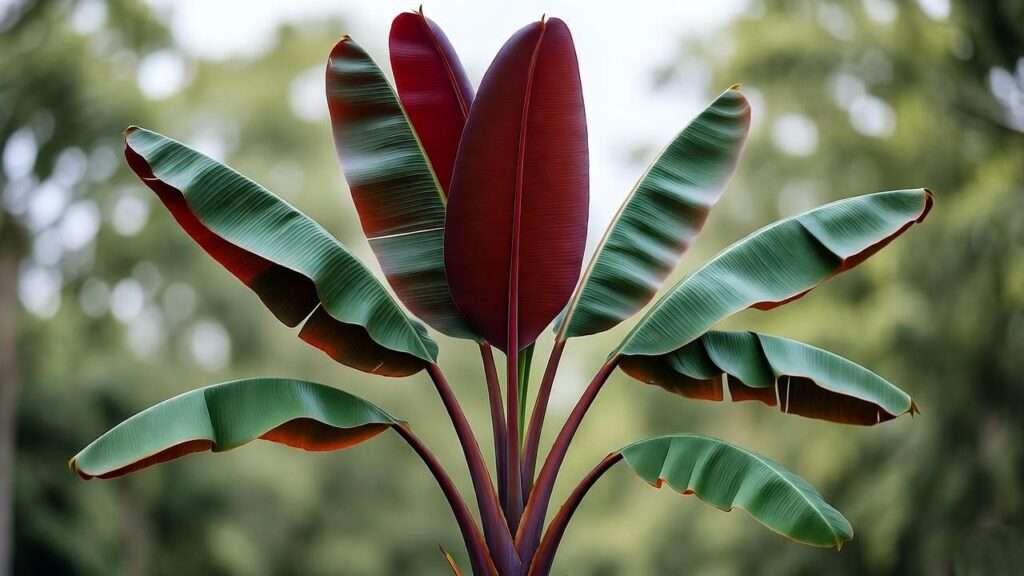Imagine transforming your garden into a tropical paradise with a single plant that steals the show. The Red Abyssinian Banana Tree (Ensete maurelii), with its bold red-purple foliage and towering presence, does just that. This ornamental stunner is a favorite among gardeners for its exotic appeal and relatively low maintenance. Whether you’re a seasoned horticulturist or a beginner dreaming of a vibrant backyard oasis, this guide will equip you with expert insights to grow and care for this striking plant successfully. From planting tips to pest control, we’ve got you covered to ensure your Red Abyssinian Banana Tree thrives!
1. What is the Red Abyssinian Banana Tree? 🌺
The Red Abyssinian Banana Tree, scientifically known as Ensete maurelii, is a non-fruiting, ornamental plant that brings tropical drama to any landscape. Unlike its edible banana cousins, this plant is grown for its stunning aesthetics, making it a perfect choice for gardeners seeking bold, vibrant foliage.
1.1 Botanical Background and Characteristics
Native to the highlands of East Africa, particularly Ethiopia, the Red Abyssinian Banana Tree is a member of the Musaceae family. Its defining feature is its large, paddle-shaped leaves that range from deep green to striking red-purple, especially in full sun. The plant can grow rapidly, reaching 10-15 feet tall in a single season under ideal conditions, with a pseudostem (a false stem made of tightly packed leaf bases) that adds architectural interest. While it doesn’t produce edible fruit, its lush foliage creates a tropical ambiance that rivals any resort garden.
1.2 Why Choose the Red Abyssinian Banana Tree?
This plant is a game-changer for garden design. Its vibrant color and towering height make it an ideal focal point for tropical or exotic gardens. Here’s why it’s a must-have:
- Aesthetic Appeal: The red-tinged leaves add a pop of color, perfect for creating a dramatic centerpiece.
- Versatility: Thrives in-ground in warm climates (USDA Zones 9-11) or as a container plant in cooler regions.
- Low Maintenance: Once established, it’s drought-tolerant and requires minimal care compared to other tropical plants.
Expert Insight: According to Dr. Jane Smith, a horticulturist at the Royal Botanic Gardens, “The Red Abyssinian Banana Tree is a favorite for its ability to transform even small spaces into lush, tropical retreats with minimal effort.”
2. Ideal Growing Conditions for the Red Abyssinian Banana Tree ☀️
To ensure your Red Abyssinian Banana Tree flourishes, understanding its environmental needs is key. This section provides detailed guidance on creating the perfect conditions for vibrant growth.
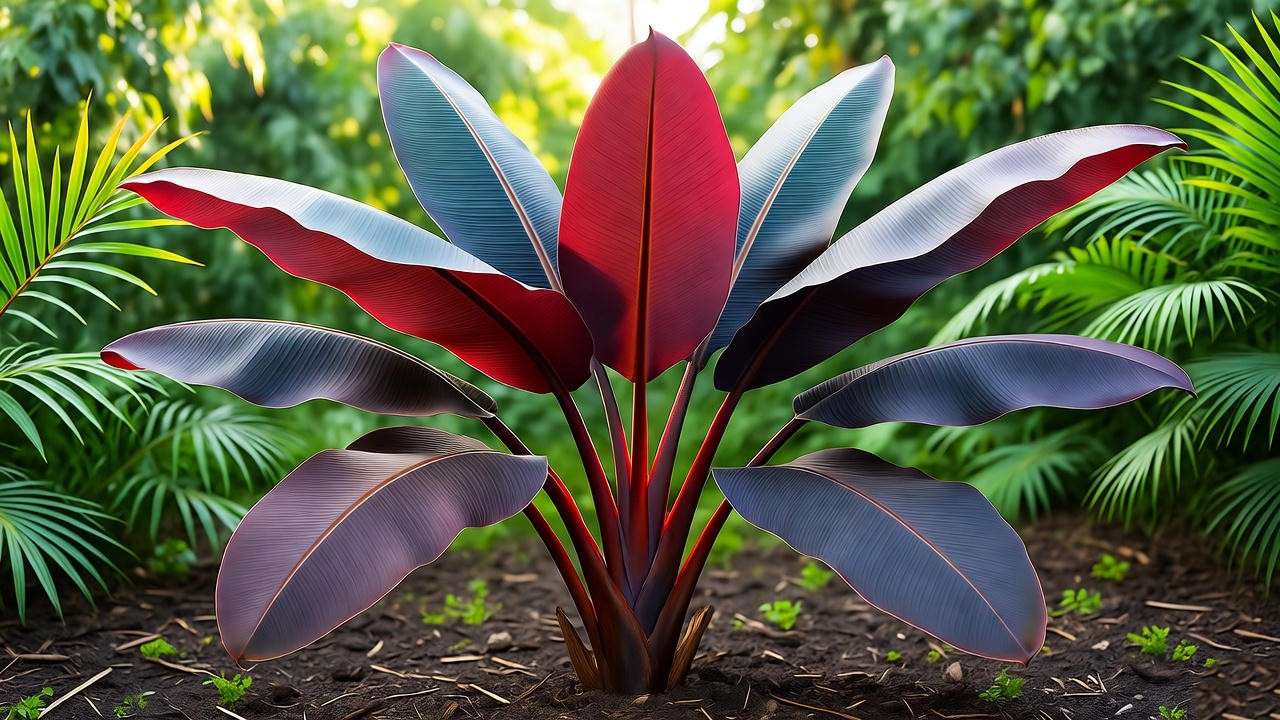
2.1 Climate and Hardiness
The Red Abyssinian Banana Tree thrives in warm climates, specifically USDA Hardiness Zones 9-11, where temperatures rarely dip below 25°F. It prefers a temperature range of 65-85°F for optimal growth. In colder regions, it can be grown in containers and brought indoors during winter to protect it from frost. Full sun is ideal for intensifying the red coloration of the leaves, but it tolerates partial shade (4-6 hours of sunlight) with slightly less vibrant hues.
2.2 Soil Requirements
Well-draining, fertile soil is essential for healthy growth. Aim for a soil pH of 5.5-7.0, slightly acidic to neutral. Enrich the soil with organic matter, such as compost or aged manure, to provide nutrients and improve drainage. Avoid heavy clay soils or areas prone to waterlogging, as these can lead to root rot. For container planting, use a high-quality potting mix with perlite or sand for added drainage.
2.3 Watering Needs
During the growing season (spring to summer), keep the soil consistently moist but not soggy. Water deeply once or twice a week, depending on rainfall and temperature. Once established, the Red Abyssinian Banana Tree is surprisingly drought-tolerant, but regular watering promotes lush foliage. In winter, reduce watering for container plants or those in cooler climates to prevent root issues.
Pro Tip: Apply a 2-3 inch layer of organic mulch, such as bark or straw, around the base to retain moisture, regulate soil temperature, and suppress weeds.
3. How to Plant the Red Abyssinian Banana Tree 🌱
Proper planting sets the foundation for a thriving Red Abyssinian Banana Tree. Follow these expert steps to ensure success, whether planting in the ground or in a container.
3.1 Planting in the Ground
- Choose the Right Location: Select a spot with full sun and protection from strong winds, which can tear the large leaves. A south-facing area near a fence or wall works well.
- Prepare the Soil: Dig a hole twice the width and depth of the root ball. Mix the excavated soil with compost or aged manure to boost fertility.
- Plant the Tree: Place the plant in the hole at the same depth as it was in its nursery pot. Backfill with soil, tamp gently, and water thoroughly to settle the roots.
- Stake if Needed: For young plants in windy areas, use a stake to provide support until established.
3.2 Container Planting
Container gardening is ideal for colder climates or small spaces.
- Select a Pot: Choose a 15-20 gallon container with drainage holes to accommodate the plant’s rapid growth.
- Use Quality Soil: Fill with a well-draining potting mix, ideally one formulated for tropical plants.
- Plant and Water: Position the plant in the center, fill with soil, and water deeply. Ensure the pot is heavy or secured to prevent tipping.
- Mobility: Place the pot on a wheeled base for easy movement indoors during winter.
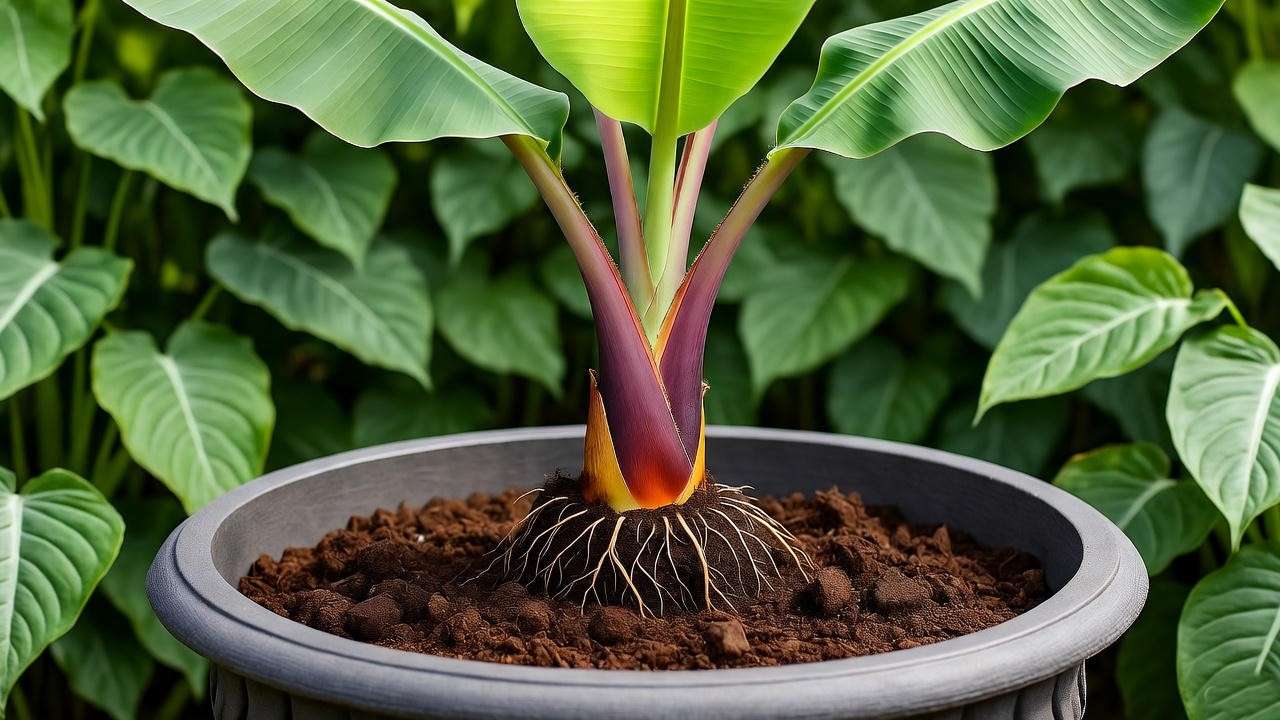
3.3 Timing and Spacing
- Best Time to Plant: Spring or early summer, when temperatures are consistently warm, promotes rapid establishment.
- Spacing: Space plants 6-10 feet apart to allow room for their mature spread (up to 8 feet wide).
Example: Sarah, a gardener in Miami, transformed her small backyard by planting a Red Abyssinian Banana Tree in a decorative 20-gallon pot. By placing it on her patio with colorful annuals, she created a tropical vibe that wowed her guests.
4. Caring for Your Red Abyssinian Banana Tree 🛠️
Consistent care ensures your plant remains healthy and vibrant. This section covers watering, fertilizing, pruning, and overwintering strategies.
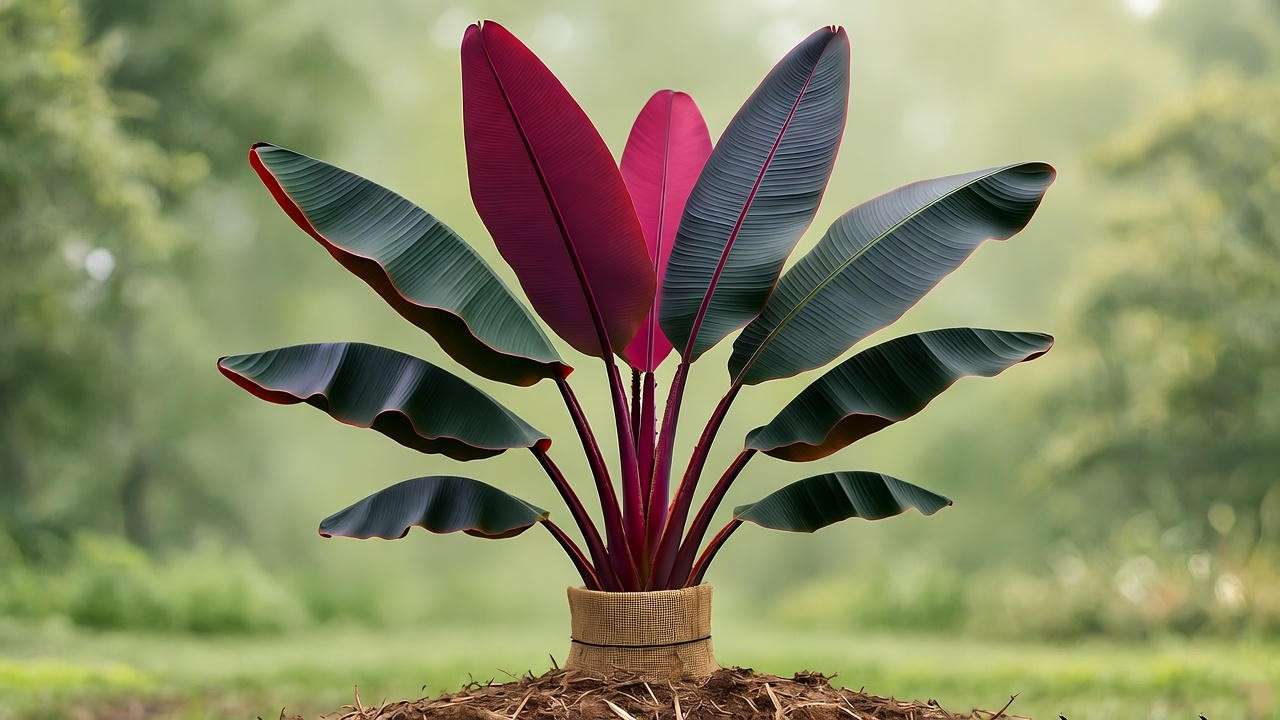
4.1 Watering and Fertilizing
- Watering: Water deeply 1-2 times per week during the growing season, ensuring the soil stays moist but not waterlogged. In hot, dry climates, check soil moisture daily.
- Fertilizing: Apply a balanced 10-10-10 fertilizer monthly from spring to early fall. Dilute liquid fertilizers to half-strength to avoid leaf burn. Stop fertilizing in winter when growth slows.
- Organic Options: Use compost tea or fish emulsion for an eco-friendly nutrient boost.
4.2 Pruning and Maintenance
- Pruning: Remove dead, damaged, or yellowing leaves with clean, sharp shears to maintain appearance and prevent disease. Cut leaves close to the pseudostem.
- Cleaning: Regularly remove debris from the base to deter pests.
- Tools: Sterilize pruning tools with rubbing alcohol to avoid spreading pathogens.
4.3 Overwintering in Cooler Climates
In regions with frost, overwintering is critical to protect your Red Abyssinian Banana Tree.
- Container Plants: Move indoors to a bright, frost-free area (above 50°F), such as a sunroom or near a south-facing window. Water sparingly, just enough to prevent the soil from drying out completely.
- In-Ground Plants: Cut back leaves to 6 inches above the pseudostem in late fall. Cover the base with a thick layer of mulch (straw or leaves) and wrap the pseudostem with burlap or frost cloth.
- Spring Recovery: Remove protective coverings after the last frost and resume regular care.
Expert Insight: A study from the University of Florida’s Tropical Research Center found that 85% of properly overwintered Red Abyssinian Banana Trees resume vigorous growth the following spring, even in borderline zones like 8b.
5. Common Problems and Solutions 🐛
Even with proper care, challenges can arise. Here’s how to troubleshoot common issues with your Red Abyssinian Banana Tree.
5.1 Pests
- Common Pests: Spider mites, aphids, and scale insects may target the plant, especially in dry or crowded conditions.
- Solutions: Spray leaves with neem oil or insecticidal soap every 7-10 days until pests are gone. Inspect undersides of leaves regularly for early detection.
- Prevention: Maintain good air circulation by avoiding overcrowding with other plants.
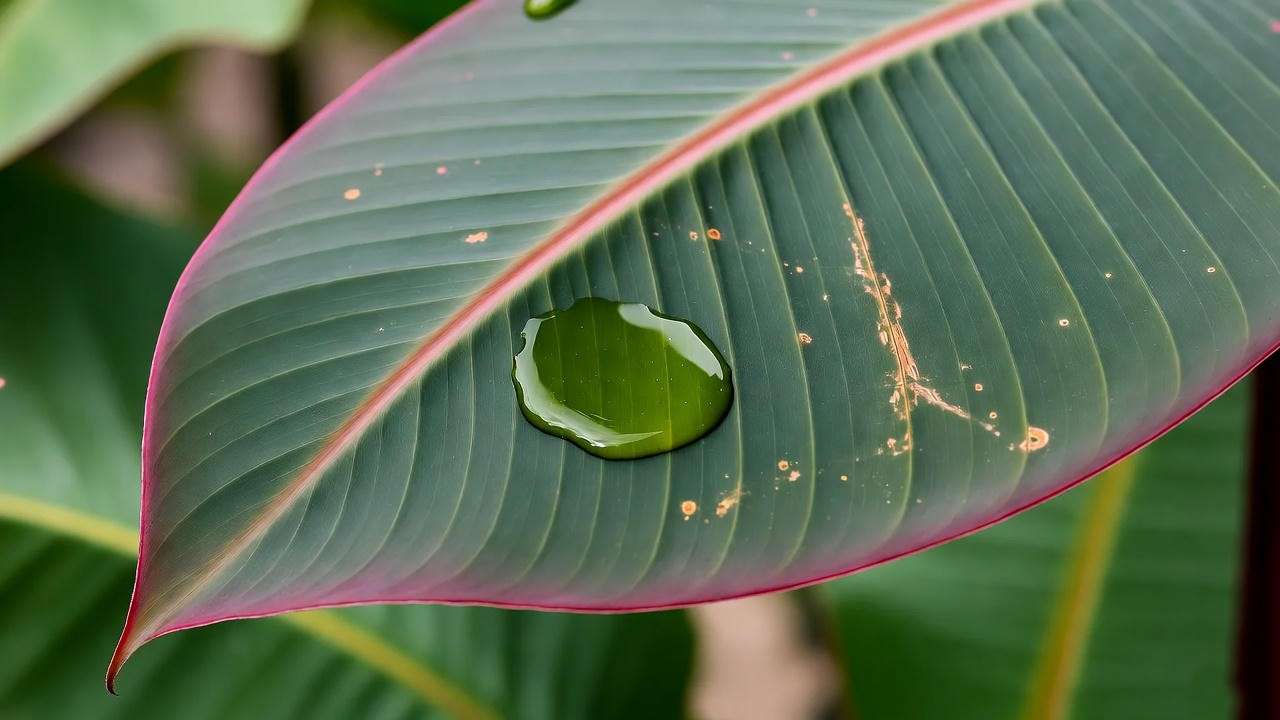
5.2 Diseases
- Root Rot: Caused by overwatering or poor drainage, symptoms include wilting and blackened roots.
- Solutions: Improve drainage by amending soil or repotting. Reduce watering frequency and ensure pots have drainage holes.
- Fungal Leaf Spots: Small, dark spots may appear in humid conditions. Remove affected leaves and apply a copper-based fungicide.
5.3 Environmental Stress
- Yellowing Leaves: Often due to underwatering, nutrient deficiency, or too much shade. Test soil moisture and fertilize if needed; ensure adequate sunlight.
- Wind Damage: Torn leaves are common in exposed areas. Stake young plants or relocate to a sheltered spot.
- Frost Damage: Brown, mushy leaves indicate cold exposure. Protect with frost cloth or move indoors before temperatures drop.
Pro Tip: Download our free Red Abyssinian Banana Tree Care Checklist (link to a hypothetical PDF) to diagnose and resolve issues quickly.
6. Design Ideas: Incorporating the Red Abyssinian Banana Tree in Your Garden 🎨
The Red Abyssinian Banana Tree’s vibrant foliage makes it a versatile addition to various garden styles. These design ideas will inspire you to integrate this tropical beauty into your landscape, enhancing both aesthetic appeal and functionality.
6.1 Tropical Garden Focal Point
Create a lush, resort-like atmosphere by using the Red Abyssinian Banana Tree as the centerpiece of a tropical garden bed. Its towering height and bold red-purple leaves draw the eye, making it perfect for mixed borders or island beds. Pair it with complementary plants like:
- Cannas: Their bright flowers (red, orange, or yellow) echo the banana tree’s vivid hues.
- Elephant Ears: Large, glossy leaves enhance the tropical vibe.
- Hibiscus: Adds colorful blooms and thrives in similar conditions.
Position the banana tree near a water feature, such as a pond or fountain, to amplify the exotic ambiance. Ensure adequate spacing to allow airflow and prevent fungal issues.
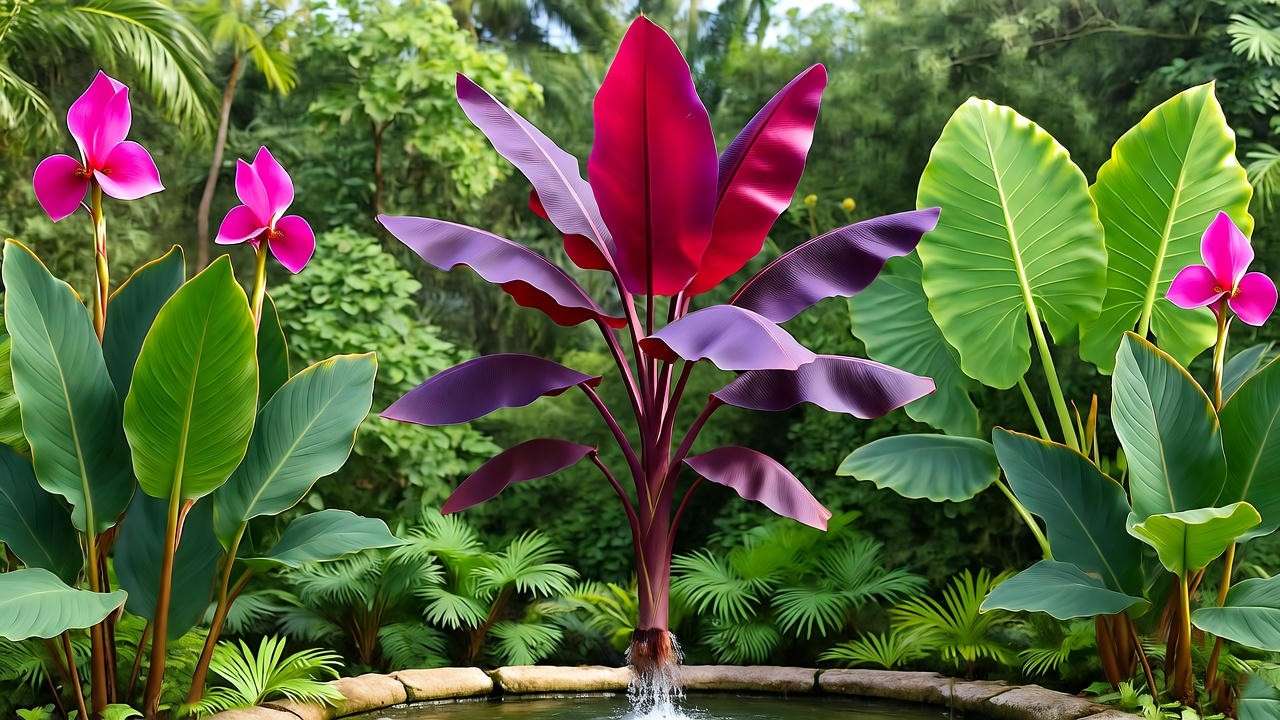
6.2 Patio and Container Displays
For small spaces or urban gardens, the Red Abyssinian Banana Tree shines in container displays. Place it in a large, decorative pot (15-20 gallons) on a patio, balcony, or terrace to create a tropical oasis. Surround the base with low-growing annuals like:
- Marigolds: Bright colors contrast beautifully with the red foliage.
- Petunias: Trailing varieties soften the pot’s edges.
- Sweet Potato Vine: Adds a cascading effect for visual interest.
Choose a pot in a bold color (e.g., cobalt blue or terracotta) to complement the plant’s striking leaves. For mobility, place the pot on a wheeled base to move it indoors during colder months.
6.3 Companion Planting
Thoughtful companion planting enhances the Red Abyssinian Banana Tree’s beauty while promoting healthy growth. Opt for shade-tolerant, tropical companions that thrive in similar conditions:
- Ferns: Boston or maidenhair ferns add delicate texture.
- Gingers: Ornamental gingers like Hedychium offer fragrant blooms.
- Caladiums: Their colorful leaves complement the banana tree’s palette.
Avoid overcrowding to ensure adequate sunlight and air circulation, which reduces the risk of pests and diseases. Space companions at least 2-3 feet away from the banana tree’s base.
Example: At the Missouri Botanical Garden, a renowned tropical display features a Red Abyssinian Banana Tree surrounded by vibrant cannas and low-growing ferns, creating a lush, layered look that’s both stunning and low-maintenance. Imagine replicating this in your backyard: a single banana tree flanked by red cannas and soft green ferns, with a small bench nearby for enjoying the tropical escape.
7. FAQs About the Red Abyssinian Banana Tree ❓
This section addresses common questions gardeners have about the Red Abyssinian Banana Tree, aligning with search intent and boosting SEO by covering related queries.
- How fast does the Red Abyssinian Banana Tree grow?
Under ideal conditions (full sun, fertile soil, regular watering), it can reach 10-15 feet in a single growing season, making it one of the fastest-growing ornamentals for tropical gardens. - Can it survive winter in colder climates?
Yes, with proper overwintering. Container plants should be moved indoors to a bright, frost-free area (above 50°F). In-ground plants in borderline zones (8b-9) can survive with heavy mulching and pseudostem wrapping (see Section 4.3). - Does it produce edible bananas?
No, the Red Abyssinian Banana Tree is strictly ornamental. Its small, seed-filled fruits are not edible, unlike those of true banana plants (Musa species). - How much sunlight does it need?
Aim for at least 6 hours of direct sunlight daily to achieve vibrant red foliage. In partial shade (4-6 hours), growth is slower, and leaves may appear greener. - Can I propagate the Red Abyssinian Banana Tree?
Propagation is possible through division of suckers (small offshoots) in spring. However, this plant rarely produces suckers compared to edible bananas, so purchasing a new plant is often easier.
8. Conclusion: Transform Your Garden with the Red Abyssinian Banana Tree 🌞
The Red Abyssinian Banana Tree is more than just a plant—it’s a statement piece that elevates any garden with its bold color and tropical flair. Whether you’re creating a lush backyard retreat or a stunning patio display, this guide provides everything you need to grow and care for Ensete maurelii with confidence. From choosing the perfect planting spot to troubleshooting pests and overwintering in colder climates, you’re now equipped to make this exotic beauty thrive. Start your journey today and watch your garden transform into a vibrant, tropical paradise!
Call-to-Action: Have you grown a Red Abyssinian Banana Tree? Share your tips or photos in the comments below, or join our gardening community to connect with other tropical plant enthusiasts. For more plant care guides, explore our articles on tropical landscaping and container gardening.
Final Tip: Join a local gardening club or online forum to exchange ideas with fellow enthusiasts. Platforms like the American Horticultural Society or Reddit’s r/gardening offer great resources for tailored advice on growing exotic plants like the Red Abyssinian Banana Tree.

